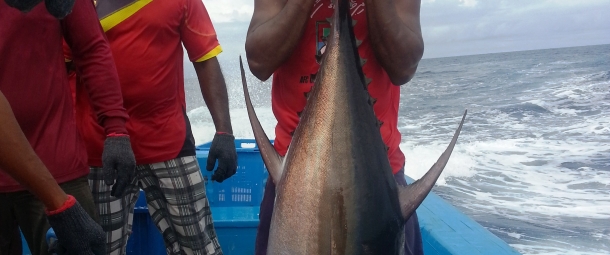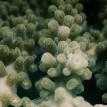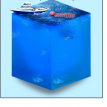
Rare type of yellowfin tuna caught in the Maldives
On October 23, 2014, fishermen of Nasru Dhoni from the island of Thoddoo, caught a fish that did not look anything like the ones they were fishing for. Unlike their target species, yellowfin tuna (Thunnus albacares), this fish had an overall black coloration, including the fins and finlets, which in yellowfin and bigeye tuna (Thunnus obesus) are bright yellow. Suspecting it to be a blackfin tuna (Thunnus atlanticus), the fishermen contacted the Marine Research Centre due to the rarity of their find.

Blackfin tuna, belonging to the same family as yellowfin and bigeye tuna (Scombridae), are common in the Western Atlantic Ocean but not in the Indian Ocean. “Despite its name of blackfin tuna, Thunnus atlanticus does not have black fins (or finlets); they are just not bright yellow as in yellowfin or bigeye tuna (Thunnus obesus)” according to Bruce B. Collette, Chair of International Union for the Conservation of Nature’s Tuna and Billfish Specialist Group. Furthermore, blackfin tuna do not grow as big as a yellowfin tuna; the maximum recorded weight for a blackfin tuna is 22.6 kg (fishbase.org), while the specimen caught by the Maldivian fishermen weighed 44kg.

Upon consultation with several leading international tuna biologists, it was concluded that the tuna that was caught by the fishermen was in fact a yellowfin tuna with a rare condition known as melanism. Melanism causes an animal to have black or nearly black pigmentation on the body. It is the opposite of albinism, or lack of pigmentation and is found in a wide variety of species in the animal kingdom. A similar specimen of melanistic yellowfin tuna was discovered from Fiji (Pacific Ocean) by Dr. Julian Pepperell. You can read about the find here.
The following experts were consulted for the identification of the fish.
Alain Fonteneau,
Institut de recherche pour le développement, France,
Bruce Colette, Ph. D.
Chair, IUCN SSC Tuna & Billfish Specialist Group, Senior Scientist
And
National Marine Fisheries Service Systematics Laboratory
National Museum of Natural History, MRC-0153
Smithsonian Institution
Washington, DC, 20013-7012, USA
Antonio Di Natale,
International Commission for the conservation of Atlantic Tunas





